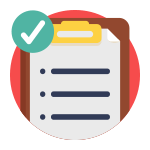Wow! That’s a great deal! Sold!
You just found a great deal while shopping online, and you’re not alone.
According to the U.S Census Bureau![]() , 10% of total retail purchases occur online. In addition to being incredibly convenient, the boom of online shopping has also brought an increase in online shopping scams and schemes that can be tricky to navigate if you don’t know what you’re looking for.
, 10% of total retail purchases occur online. In addition to being incredibly convenient, the boom of online shopping has also brought an increase in online shopping scams and schemes that can be tricky to navigate if you don’t know what you’re looking for.
Here are some of the best ways to protect yourself before, during, and after an online shopping transaction.
Confirm Who You’re Dealing With
It’s so easy today for individuals to set up an online shopping site.
This includes the bad guys. Make sure that whoever you’re dealing with is who they say they are.
Check the physical address of the online seller and make sure they have a valid phone number just in case you have questions or product problems.
Google the site to make sure that it’s not being flagged by fraud reporting databases.
Google to see reviews of said website and do a little investigating to see what other customers experienced. However, you should keep an eye out for gamed reviews. If there is only positive feedback, it could mean that they are buying fake reviews (or, it could mean that it’s just a really excellent product).
 Guard Your Information
Guard Your Information
After you’ve vetted a prospective business and begin a transaction, continue to keep your guard up.
Keep it cashless. Never – ever pay for online goods with cash or a money transfer. It removes any kind of consumer protection and gives you no recourse in the event of a product problem. If you use a credit card, your purchase falls under the protection of the Fair Credit Billing Act, and the threat of a chargeback is typically enough to ensure a vendor honors their end of a deal.
Make sure you’re secure. Check out the URL of the payment page and make sure that it starts with the letters “HTTPS” (Not “HTTP”). This indicates that your connection is secure and that the company is working to protect your information. If you get a pop-up message or email that requests payment, run (well, close out the browser). Legitimate companies don’t request payment information that way.
 The Gray-Market Is a Gamble
The Gray-Market Is a Gamble
If it seems like it’s too good to be true, it most likely is.
Which means you’re rolling the dice when you purchase products on the “gray market.” Discount Rolex watches, Counterfeit “Kate Spade” Handbags, Discount Textbooks, Alternative source electronics, and so on. In addition to hurting the brands that produce the products, gray-market merchandise often also leaves you with little to no recourse in the case of product issues.
One of the reasons that Yeti is so expensive is because the producers stand behind the product and will replace it if there’s a defect. If you purchase a knock-off that’s not covered by a warranty and there’s a problem, you’re out of luck. If a product isn’t worth paying full price for, it’s probably not worth buying at all.
 Go Old-School: Balance The Checkbook
Go Old-School: Balance The Checkbook
The age of digital money has made it easier to keep up with your finances. However, the ease of checking your bank account total has led to the decline of the art of checkbook balancing – manually entering every ledger item and comparing it to your bank statement to ensure accuracy.
The first step a cybercriminal takes with your stolen credit card information is to perform a series of “test swipes.” These are a series of small transaction ranging from $1 to $50 and typically don’t run authorizations or require signatures. After the validity of a card has been confirmed, they will use it to make a series of large purchases back to back in hopes that you won’t notice until a significant amount of money has been stolen.
There is typically a gap in time between the test swipes and the more significant purchases which gives you a chance to catch the fraudulent charges – if you’re vigilant. Take a few minutes every week (or more frequently) to review all of your financial transactions and flag any charges that you don’t recognize (especially if they are under $50). This practice can help you identify that your information has been compromised.

